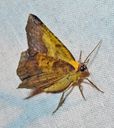Ourapterygini
Ourapterygini
Classification
- Phylum: Arthropoda
- Subphylum: Hexapoda
- Class: Insecta
- Order: Lepidoptera
- Superfamily: Geometroidea
- Family: Geometridae
- Subfamily: Ennominae
- Tribe: Ourapterygini
Pronunciation
How to pronounce Ourapterygini: /ˌaʊrəpˌtɛrɪˈdʒaɪnaɪ/
These audio files are automatically generated. While they are not always 100% accurate, they are a good starting point.
Images






Summary
The Ourapterygini is a tribe of geometer moths noted for their resemblance to butterflies and their unique coloration, particularly in the context of aposematism. They are predominantly found in Neotropical regions, featuring asymmetrical processes of the anellus and a higher occurrence of diurnal species compared to other geometer moths.
Physical Characteristics
Members of the Ourapterygini tribe often exhibit butterfly-like features, with a tendency towards light yellowish hues and bold patterns rather than typical cryptic coloration.
Identification Tips
Look for species that are diurnal and have prominent patterns, distinguishing them from the cryptic species typical of many geometer moths.
Habitat
Primarily found in the Neotropics, where they inhabit various environments.
Distribution
Plentiful in the Neotropic regions; specific distribution details of genera are not outlined due to incomplete taxonomic classification.
Diet
Details on diet specific to the tribe are not provided, but members typically feed on plant materials as larvae.
Life Cycle
The specific details of the life cycle for the tribe are not documented.
Reproduction
Reproductive methods are not specifically described for the tribe.
Predators
Some species are known to be noxious to predators, potentially deterring them with aposematic coloration.
Ecosystem Role
Their role in the ecosystem is not specified in the provided data.
Evolution
The tribe is considered one of the youngest within the subfamily Ennominae, exhibiting unique morphological traits.
Misconceptions
Many species have been mistaken for true butterflies due to their appearance and behaviors.
Tags
- geometer moths
- Ennominae
- Ourapterygini
- Lepidoptera
- aposematism
- diurnal species